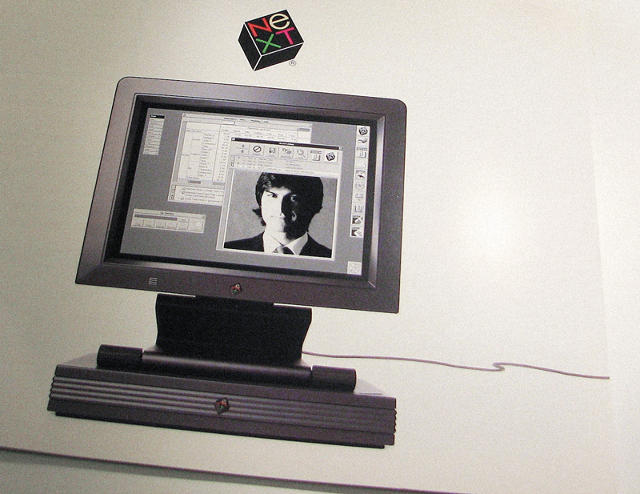
While making the recent Steve Jobs biopic, researchers working for Aaron Sorkin found a VHS tape containing a long-lost video of Jobs launching the NeXT workstation in 1988, the eponymous first computer of his second computer company, also called NeXT. While the Mac was for home consumers, the NeXT workstation was for education and enterprise, but as the video makes clear, there's more to NeXT's legacy than that. Unlike Apple, NeXT was founded from the ground up as a design-thinking company, with some huge design talent attached.
The first designer who teamed up with Jobs for NeXT was graphic design legend Paul Rand, who developed the NeXT brand identity, including its colorful, skewed, boxy logo. Rand was 71 at the time, and had previously designed the logos for Esquire, IBM, ABC, and UPS, among many others. After badgering IBM to make an exception for NeXT when it came to Rand's contract, Jobs approached the designer in 1986, almost three years before the first NeXT computer hit shelves and just months after leaving Apple.
When Rand flew out to Palo Alto, Jobs told him that his next computer would be a perfect cube (a shape Jobs returned to when he came back to Apple with the still-beloved PowerMac G4 Cube). So Rand pitched him a cube, tilted at a 28-degree angle. As recounted in Walter Isaacson's official Steve Jobs biography, Jobs wasn't so sure about this. He demanded tons of options to consider. Rand sneered at him. "I will solve your problem, and you will pay me," he told Jobs. "You can use what I produce, or not, but I will not do options, and either way you will pay me."

At the end of the day, Rand had his way. Jobs payed him $100,000 to design the NeXT identity, a staggering amount for the time, especially considering the fact that the contract between the two did not allow for any back and forth: Jobs had to take what he got. When Rand finally revealed his design to Jobs, the NeXT CEO only had one complaint—he thought the yellow used in the "e" was too dark, and asked Rand to change it. Rand reportedly smashed his fist on the table and screamed at Jobs: "I've been doing this for 50 years! I know what I'm doing." Jobs ended up losing the argument. The color stayed, making Rand one of the few people in the history of the world who ever won a head-to-head argument against Jobs.
Here's a great video of Rand debuting the identity to Jobs and his NeXT team (including a young Susan Kare).
The other great designer who helped make the NeXT a reality was Hartmut Esslinger. The founder of Frog Design, Esslinger had previously worked with Jobs to conceptualize some very weird and outré designs for future Apple products, none of which ever hit the market. He also helped create the so-called "Snow White design language" of industrial design that Apple used for all of its computers starting with the Apple IIc, and continuing until 1990.
When Jobs started NeXT, Esslinger jumped ship, winding down his contract with Apple and helping Jobs realize his dream computer. Each side of the NeXT computer was to be exactly a foot long, a mathematically perfect cube that made it a nightmare to actually produce.

As Isaacson relates in Steve Jobs, most parts cast in molds have an angle that is slightly greater than 90 degrees, because the extra degrees make it much easier to get the parts out of the mold. That's the kind of compromise neither Esslinger or Jobs was willing to make for the NeXT, arguing it would ruin the "purity and perfection" of the NeXT cube. So the sides had to be produced separately, using molds that cost $650,000, at a specialty machine shop in Chicago. A manic attention to detail went even as far as the inside of the NeXT computer. Not only did all of the screws feature expensive plating, the inside of the magnesium case was a fancy matte black, even though almost no one would ever see it.

For all NeXT's design flourish, the company didn't actually sell that many computers: about 50,000 units all told. Part of the issue was the computer's price: $6,500 when it first debuted. Yet, it's misguided to call NeXT, as some sites have, "Steve Jobs's biggest failure."
NeXT's design legacy reaches beyond its hardware and logo. Do you use a Mac? OS X is a modified version of NeXTStep, the operating system Jobs created for NeXT. And because they were graphical powerhouses, NeXT computers were responsible for many of the advances in 3-D graphics that came out of the late '80s and '90s. Not only do we owe games such as Doom and Quake to NeXT computers, we also owe NeXT for empowering programmers who created revolutionary new techniques in computer graphics that are still used in computer-animated blockbusters and Oculus Rift games to this day. Apple became a design-thinking company by accident, but NeXT was one on purpose, and it revolutionized the world. If that's Steve Jobs's "biggest failure," it's a shame he didn't fail more often.